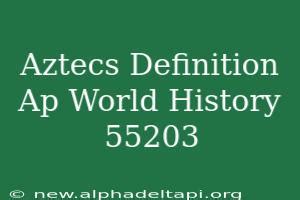Introduction
The Aztecs, a Mesoamerican civilization that flourished in central Mexico from the 14th to the 16th centuries, hold a significant place in AP World History. Their advanced civilization, architectural achievements, and complex political and social structures have fascinated scholars and students alike. This article provides a comprehensive definition of the Aztecs, exploring various aspects of their history, culture, and impact on world history.

Historical Timeline
- 1325: The Aztecs founded Tenochtitlan, their capital city on an island in Lake Texcoco.
- 1428: The Aztec Triple Alliance was formed between Tenochtitlan, Texcoco, and Tlacopan, marking the beginning of Aztec dominance in the region.
- 1519: Spanish explorer Hernán Cortés arrived on the coast of Mexico, marking the onset of European contact.
- 1521: The Spanish, aided by indigenous allies, conquered Tenochtitlan, leading to the collapse of the Aztec Empire.
Political Structure
The Aztec civilization was highly centralized, with the emperor at the apex of a hierarchical political structure. The emperor, known as the Huey Tlatoani, held absolute power and was considered a divine figure. The Aztec capital, Tenochtitlan, served as the administrative and political center of the empire.
Social Structure
Aztec society was highly stratified, with several distinct social classes:
– Nobles: The elite class included the emperor, high-ranking officials, and priests.
– Commoners: Most Aztecs belonged to this class, which included farmers, artisans, and merchants.
– Slaves: Slaves were primarily prisoners of war who served as domestic laborers or were sacrificed in religious ceremonies.
Cultural Achievements
The Aztecs were renowned for their architectural prowess, artistic skill, and scientific knowledge.
– Architecture: The Aztecs built impressive temples, palaces, and pyramids, including the iconic Templo Mayor in Tenochtitlan.
– Art: Aztec art featured vibrant murals, sculptures, and jewelry that depicted religious themes, historical events, and everyday life.
– Science: The Aztecs had an advanced understanding of astronomy, mathematics, and medicine. They developed a sophisticated calendar and used a form of writing known as Nahuatl.
Economic System
The Aztec economy was based on agriculture, with staple crops such as maize, beans, and squash. They also practiced extensive trade and had a complex market system. The Aztecs imposed tributes on conquered territories, which contributed to their wealth and power.
Religious Beliefs
The Aztecs had a polytheistic belief system, with a pantheon of over 200 deities. The most important gods included Huitzilopochtli (the god of war), Tlaloc (the rain god), and Quetzalcoatl (the feathered serpent god). The Aztecs believed in sacrificing humans and animals to appease their deities.
Impact on World History
The Aztecs left a lasting impact on world history:
– Cultural Exchange: The Spanish conquest of the Aztec Empire introduced European goods, ideas, and diseases to Mesoamerica, leading to significant cultural exchange.
– Historical Legacy: The Aztec civilization continues to fascinate scholars and inspire research on Mesoamerican history and culture.
– Contemporary Influences: Aztec art, symbols, and traditions have influenced modern Mexican culture and identity.
Tables
| Table 1: Aztec Emperors and Reigning Periods |
|—|—|
| Emperor | Reigning Period |
| Montezuma I | 1440-1469 |
| Axayacatl | 1469-1481 |
| Tizoc | 1481-1486 |
| Ahuizotl | 1486-1502 |
| Montezuma II | 1502-1520 |
| Table 2: Aztec Social Classes |
|—|—|
| Class | Description |
| Nobles | Elite class, including the emperor, officials, and priests |
| Commoners | Majority of the population, including farmers, artisans, and merchants |
| Slaves | Prisoners of war, used as laborers or sacrificed in ceremonies |
| Table 3: Aztec Gods and Their Significance |
|—|—|
| God | Significance |
| Huitzilopochtli | God of war, patron deity of Tenochtitlan |
| Tlaloc | God of rain, fertility, and thunder |
| Quetzalcoatl | Feathered serpent god, associated with wisdom, creation, and the wind |
| Table 4: Aztec Architectural Structures |
|—|—|
| Structure | Description |
| Templo Mayor | The main temple in Tenochtitlan, dedicated to Huitzilopochtli and Tlaloc |
| Palace of Axayacatl | The residence of the Aztec emperor Axayacatl |
| Great Pyramid of Cholula | The largest pyramid in the world by volume, dedicated to Tlaloc |
FAQs
1. What was the name of the Aztec capital city?
– Tenochtitlan
2. When did the Spanish conquer the Aztec Empire?
– 1521
3. Who was the most famous Aztec emperor?
– Montezuma II
4. What was the main economic activity of the Aztecs?
– Agriculture
5. What was the Aztec belief system called?
– Polytheism
6. What is the significance of the Templo Mayor?
– It was the main temple in Tenochtitlan, dedicated to Huitzilopochtli and Tlaloc.
7. What is the modern-day legacy of the Aztecs?
– Their art, symbols, and traditions continue to influence Mexican culture and identity.
8. Why did the Spanish conquer the Aztec Empire?
– A combination of military superiority, political alliances, and diseases
